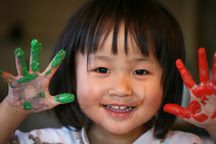 Art education can come to life when you engage a child’s senses during the creative process. Creativity is such an important part of every child’s development. You can inspire your child’s creativity by adding music and even movement. Art for kids can be made more magical when you combine art forms, such as tuning your child into some Japanese folk music while working with Chigirie (paper art) – for an activity go to: http://www.abrakadoodle.com/press/chigirie_0906.htm. It is a great way to give your child an appreciation for the arts and cultures while exploring them. Music can also help set the tone for a creative sketch. Your child may find that
Art education can come to life when you engage a child’s senses during the creative process. Creativity is such an important part of every child’s development. You can inspire your child’s creativity by adding music and even movement. Art for kids can be made more magical when you combine art forms, such as tuning your child into some Japanese folk music while working with Chigirie (paper art) – for an activity go to: http://www.abrakadoodle.com/press/chigirie_0906.htm. It is a great way to give your child an appreciation for the arts and cultures while exploring them. Music can also help set the tone for a creative sketch. Your child may find that  certain classical or jazz or contemporary soundtracks help activate his or her imagination. Encourage your child to show movement in an art creation – whether it be a modeling compound or swirling paint on paper – and then suggest that your child move or dance as a further expression of that creation.
certain classical or jazz or contemporary soundtracks help activate his or her imagination. Encourage your child to show movement in an art creation – whether it be a modeling compound or swirling paint on paper – and then suggest that your child move or dance as a further expression of that creation. Use art combined with music and movement next time your child wants to express his or her creativity. Ask your child what kind of music will help set the mood for making art. Play with creative movement by suggesting that your child demonstrate how a
 butterfly moves, and then set it to paper while listening to music reminiscent of spring and summer. Talk with your child about his or her feelings and the energy of his or her creation as this creative process continues, because emotions, beliefs and ideas are such a big part of art education. Your child will love it! Art for kids can come to life in beautiful ways by adding a few art supplies, music, movement and interactive encouragement with just a dash of guidance.
butterfly moves, and then set it to paper while listening to music reminiscent of spring and summer. Talk with your child about his or her feelings and the energy of his or her creation as this creative process continues, because emotions, beliefs and ideas are such a big part of art education. Your child will love it! Art for kids can come to life in beautiful ways by adding a few art supplies, music, movement and interactive encouragement with just a dash of guidance.



